Financial Analysis of Tesco Plc: Finance Report MARK3005
VerifiedAdded on 2022/09/09
|14
|2406
|52
Report
AI Summary
This report provides a comprehensive financial analysis of Tesco Plc, evaluating its financial position, market share, and future strategies. The analysis covers the period from 2017 to 2019, assessing revenue trends, gross and net profit margins, and key financial ratios such as debt-to-equity and current ratios. A comparison with its competitor, J Sainsbury Plc, offers insights into Tesco's relative performance. The report also examines Tesco's market position, its ranking among global retailers, and its geographical diversification. Furthermore, it delves into Tesco's future plans, including strategies related to customer engagement, innovation, and corporate governance, and assesses the impact of these plans on its retail strategy. The conclusion summarizes Tesco's financial health, market strength, and the potential benefits of its future initiatives.
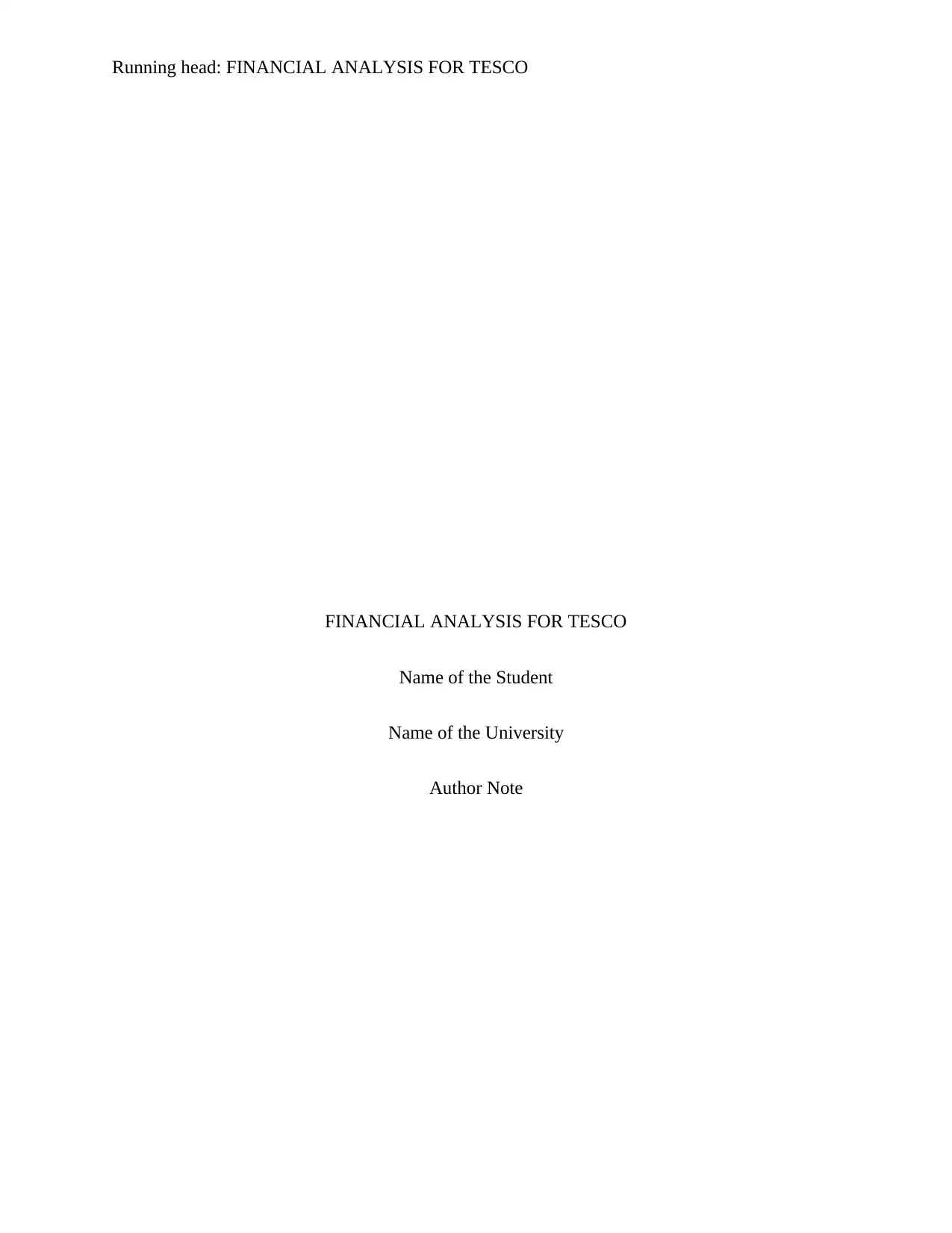
Running head: FINANCIAL ANALYSIS FOR TESCO
FINANCIAL ANALYSIS FOR TESCO
Name of the Student
Name of the University
Author Note
FINANCIAL ANALYSIS FOR TESCO
Name of the Student
Name of the University
Author Note
Paraphrase This Document
Need a fresh take? Get an instant paraphrase of this document with our AI Paraphraser
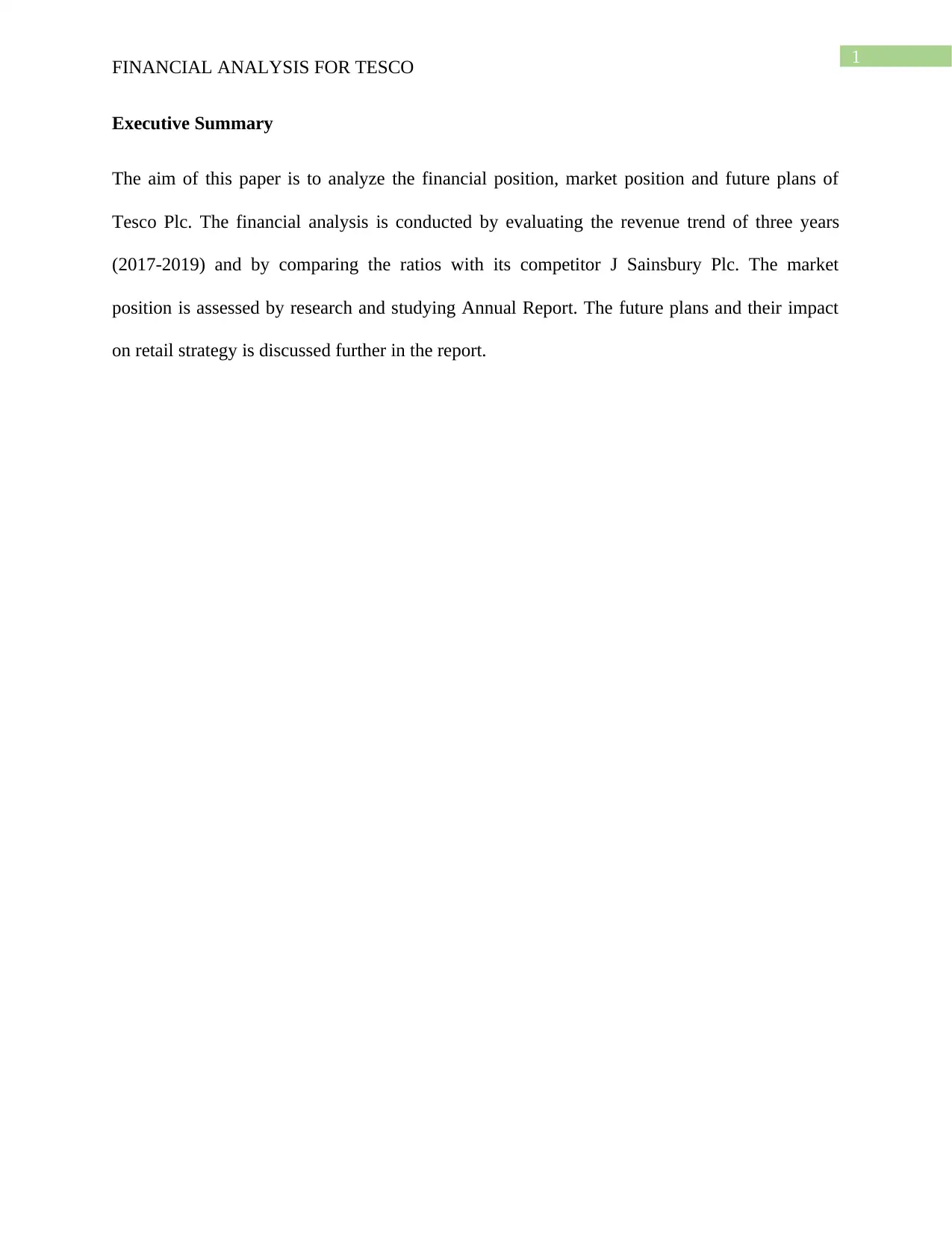
1
FINANCIAL ANALYSIS FOR TESCO
Executive Summary
The aim of this paper is to analyze the financial position, market position and future plans of
Tesco Plc. The financial analysis is conducted by evaluating the revenue trend of three years
(2017-2019) and by comparing the ratios with its competitor J Sainsbury Plc. The market
position is assessed by research and studying Annual Report. The future plans and their impact
on retail strategy is discussed further in the report.
FINANCIAL ANALYSIS FOR TESCO
Executive Summary
The aim of this paper is to analyze the financial position, market position and future plans of
Tesco Plc. The financial analysis is conducted by evaluating the revenue trend of three years
(2017-2019) and by comparing the ratios with its competitor J Sainsbury Plc. The market
position is assessed by research and studying Annual Report. The future plans and their impact
on retail strategy is discussed further in the report.
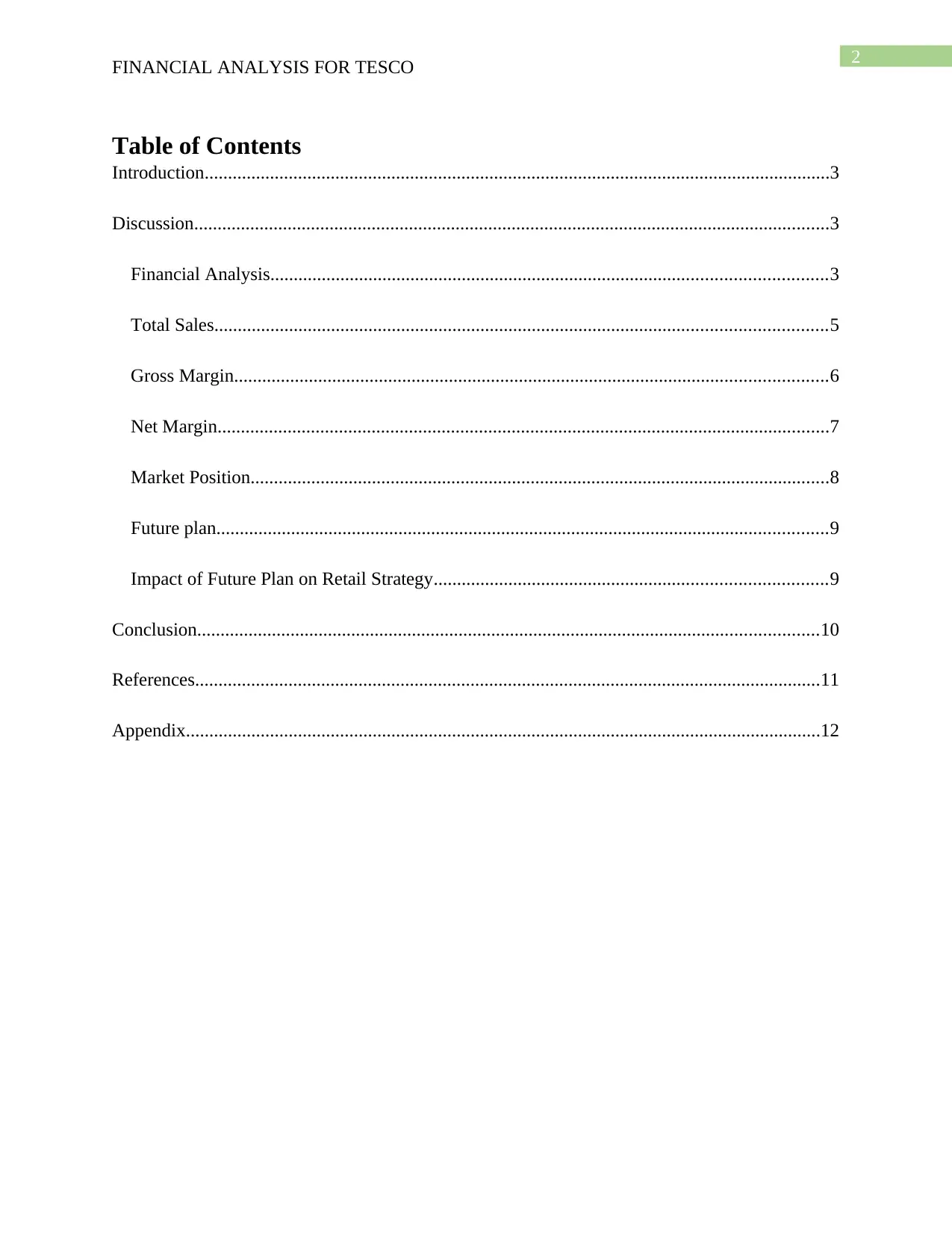
2
FINANCIAL ANALYSIS FOR TESCO
Table of Contents
Introduction......................................................................................................................................3
Discussion........................................................................................................................................3
Financial Analysis.......................................................................................................................3
Total Sales...................................................................................................................................5
Gross Margin...............................................................................................................................6
Net Margin...................................................................................................................................7
Market Position............................................................................................................................8
Future plan...................................................................................................................................9
Impact of Future Plan on Retail Strategy....................................................................................9
Conclusion.....................................................................................................................................10
References......................................................................................................................................11
Appendix........................................................................................................................................12
FINANCIAL ANALYSIS FOR TESCO
Table of Contents
Introduction......................................................................................................................................3
Discussion........................................................................................................................................3
Financial Analysis.......................................................................................................................3
Total Sales...................................................................................................................................5
Gross Margin...............................................................................................................................6
Net Margin...................................................................................................................................7
Market Position............................................................................................................................8
Future plan...................................................................................................................................9
Impact of Future Plan on Retail Strategy....................................................................................9
Conclusion.....................................................................................................................................10
References......................................................................................................................................11
Appendix........................................................................................................................................12
⊘ This is a preview!⊘
Do you want full access?
Subscribe today to unlock all pages.

Trusted by 1+ million students worldwide
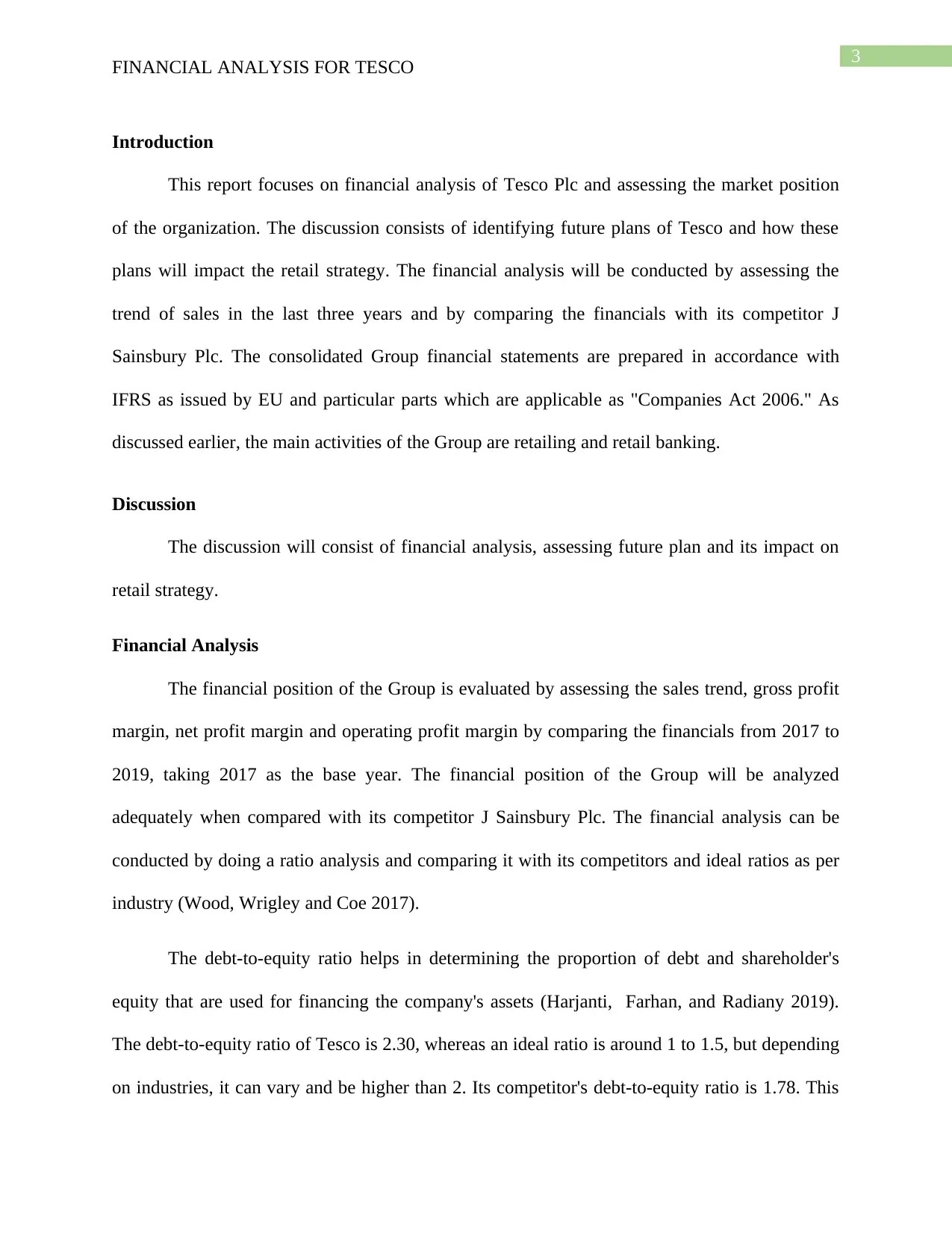
3
FINANCIAL ANALYSIS FOR TESCO
Introduction
This report focuses on financial analysis of Tesco Plc and assessing the market position
of the organization. The discussion consists of identifying future plans of Tesco and how these
plans will impact the retail strategy. The financial analysis will be conducted by assessing the
trend of sales in the last three years and by comparing the financials with its competitor J
Sainsbury Plc. The consolidated Group financial statements are prepared in accordance with
IFRS as issued by EU and particular parts which are applicable as "Companies Act 2006." As
discussed earlier, the main activities of the Group are retailing and retail banking.
Discussion
The discussion will consist of financial analysis, assessing future plan and its impact on
retail strategy.
Financial Analysis
The financial position of the Group is evaluated by assessing the sales trend, gross profit
margin, net profit margin and operating profit margin by comparing the financials from 2017 to
2019, taking 2017 as the base year. The financial position of the Group will be analyzed
adequately when compared with its competitor J Sainsbury Plc. The financial analysis can be
conducted by doing a ratio analysis and comparing it with its competitors and ideal ratios as per
industry (Wood, Wrigley and Coe 2017).
The debt-to-equity ratio helps in determining the proportion of debt and shareholder's
equity that are used for financing the company's assets (Harjanti, Farhan, and Radiany 2019).
The debt-to-equity ratio of Tesco is 2.30, whereas an ideal ratio is around 1 to 1.5, but depending
on industries, it can vary and be higher than 2. Its competitor's debt-to-equity ratio is 1.78. This
FINANCIAL ANALYSIS FOR TESCO
Introduction
This report focuses on financial analysis of Tesco Plc and assessing the market position
of the organization. The discussion consists of identifying future plans of Tesco and how these
plans will impact the retail strategy. The financial analysis will be conducted by assessing the
trend of sales in the last three years and by comparing the financials with its competitor J
Sainsbury Plc. The consolidated Group financial statements are prepared in accordance with
IFRS as issued by EU and particular parts which are applicable as "Companies Act 2006." As
discussed earlier, the main activities of the Group are retailing and retail banking.
Discussion
The discussion will consist of financial analysis, assessing future plan and its impact on
retail strategy.
Financial Analysis
The financial position of the Group is evaluated by assessing the sales trend, gross profit
margin, net profit margin and operating profit margin by comparing the financials from 2017 to
2019, taking 2017 as the base year. The financial position of the Group will be analyzed
adequately when compared with its competitor J Sainsbury Plc. The financial analysis can be
conducted by doing a ratio analysis and comparing it with its competitors and ideal ratios as per
industry (Wood, Wrigley and Coe 2017).
The debt-to-equity ratio helps in determining the proportion of debt and shareholder's
equity that are used for financing the company's assets (Harjanti, Farhan, and Radiany 2019).
The debt-to-equity ratio of Tesco is 2.30, whereas an ideal ratio is around 1 to 1.5, but depending
on industries, it can vary and be higher than 2. Its competitor's debt-to-equity ratio is 1.78. This
Paraphrase This Document
Need a fresh take? Get an instant paraphrase of this document with our AI Paraphraser
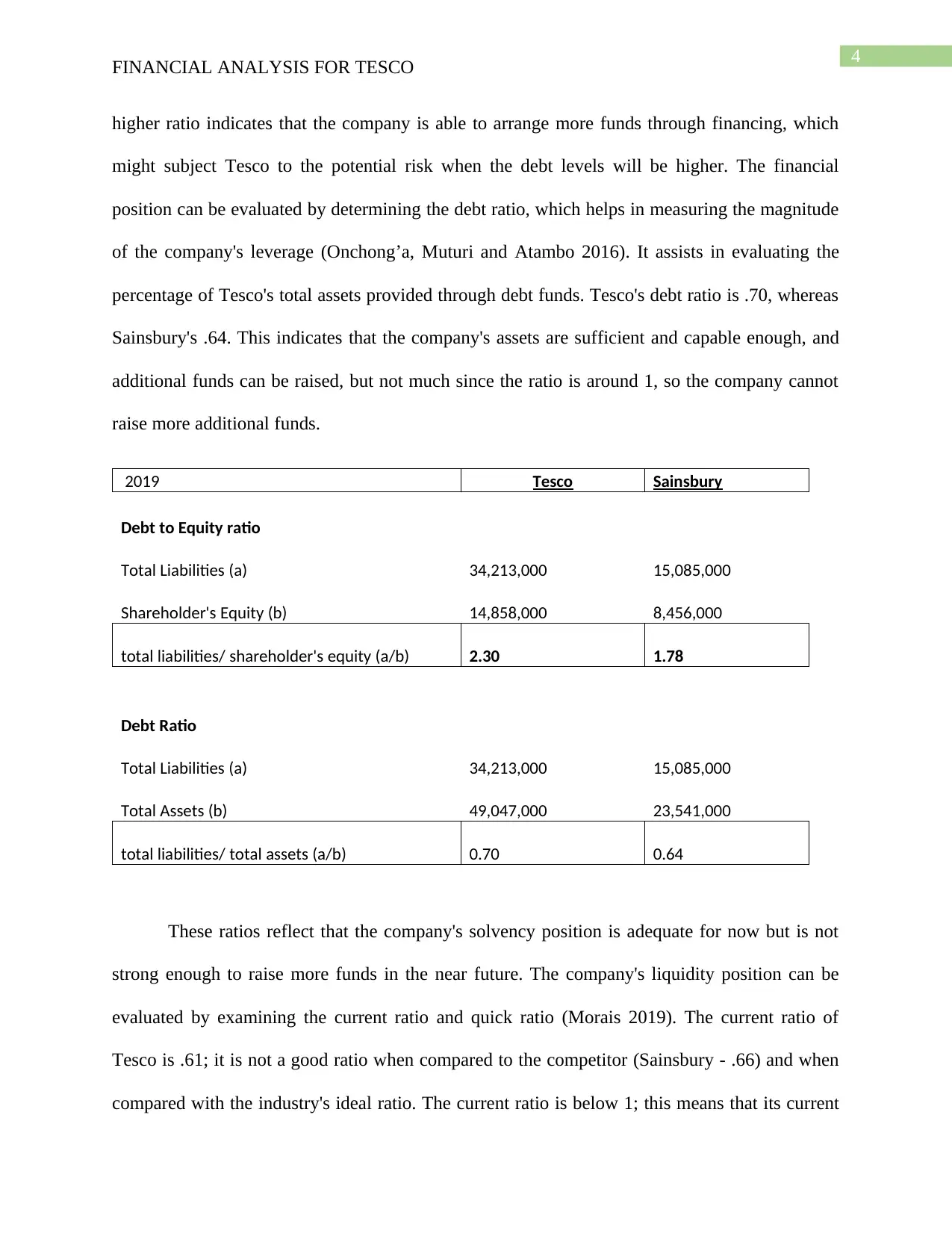
4
FINANCIAL ANALYSIS FOR TESCO
higher ratio indicates that the company is able to arrange more funds through financing, which
might subject Tesco to the potential risk when the debt levels will be higher. The financial
position can be evaluated by determining the debt ratio, which helps in measuring the magnitude
of the company's leverage (Onchong’a, Muturi and Atambo 2016). It assists in evaluating the
percentage of Tesco's total assets provided through debt funds. Tesco's debt ratio is .70, whereas
Sainsbury's .64. This indicates that the company's assets are sufficient and capable enough, and
additional funds can be raised, but not much since the ratio is around 1, so the company cannot
raise more additional funds.
2019 Tesco Sainsbury
Debt to Equity ratio
Total Liabilities (a) 34,213,000 15,085,000
Shareholder's Equity (b) 14,858,000 8,456,000
total liabilities/ shareholder's equity (a/b) 2.30 1.78
Debt Ratio
Total Liabilities (a) 34,213,000 15,085,000
Total Assets (b) 49,047,000 23,541,000
total liabilities/ total assets (a/b) 0.70 0.64
These ratios reflect that the company's solvency position is adequate for now but is not
strong enough to raise more funds in the near future. The company's liquidity position can be
evaluated by examining the current ratio and quick ratio (Morais 2019). The current ratio of
Tesco is .61; it is not a good ratio when compared to the competitor (Sainsbury - .66) and when
compared with the industry's ideal ratio. The current ratio is below 1; this means that its current
FINANCIAL ANALYSIS FOR TESCO
higher ratio indicates that the company is able to arrange more funds through financing, which
might subject Tesco to the potential risk when the debt levels will be higher. The financial
position can be evaluated by determining the debt ratio, which helps in measuring the magnitude
of the company's leverage (Onchong’a, Muturi and Atambo 2016). It assists in evaluating the
percentage of Tesco's total assets provided through debt funds. Tesco's debt ratio is .70, whereas
Sainsbury's .64. This indicates that the company's assets are sufficient and capable enough, and
additional funds can be raised, but not much since the ratio is around 1, so the company cannot
raise more additional funds.
2019 Tesco Sainsbury
Debt to Equity ratio
Total Liabilities (a) 34,213,000 15,085,000
Shareholder's Equity (b) 14,858,000 8,456,000
total liabilities/ shareholder's equity (a/b) 2.30 1.78
Debt Ratio
Total Liabilities (a) 34,213,000 15,085,000
Total Assets (b) 49,047,000 23,541,000
total liabilities/ total assets (a/b) 0.70 0.64
These ratios reflect that the company's solvency position is adequate for now but is not
strong enough to raise more funds in the near future. The company's liquidity position can be
evaluated by examining the current ratio and quick ratio (Morais 2019). The current ratio of
Tesco is .61; it is not a good ratio when compared to the competitor (Sainsbury - .66) and when
compared with the industry's ideal ratio. The current ratio is below 1; this means that its current
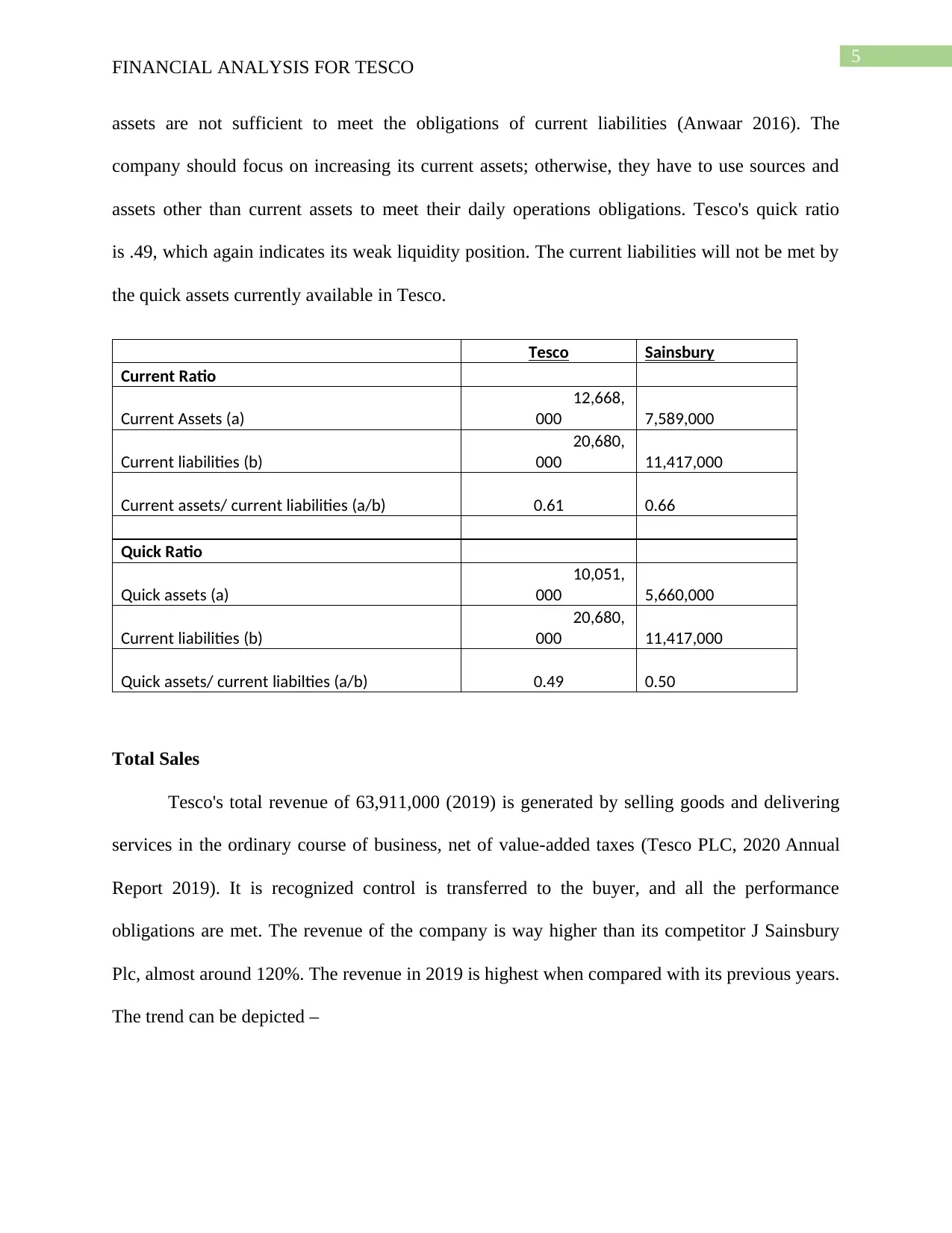
5
FINANCIAL ANALYSIS FOR TESCO
assets are not sufficient to meet the obligations of current liabilities (Anwaar 2016). The
company should focus on increasing its current assets; otherwise, they have to use sources and
assets other than current assets to meet their daily operations obligations. Tesco's quick ratio
is .49, which again indicates its weak liquidity position. The current liabilities will not be met by
the quick assets currently available in Tesco.
Tesco Sainsbury
Current Ratio
Current Assets (a)
12,668,
000 7,589,000
Current liabilities (b)
20,680,
000 11,417,000
Current assets/ current liabilities (a/b) 0.61 0.66
Quick Ratio
Quick assets (a)
10,051,
000 5,660,000
Current liabilities (b)
20,680,
000 11,417,000
Quick assets/ current liabilties (a/b) 0.49 0.50
Total Sales
Tesco's total revenue of 63,911,000 (2019) is generated by selling goods and delivering
services in the ordinary course of business, net of value-added taxes (Tesco PLC, 2020 Annual
Report 2019). It is recognized control is transferred to the buyer, and all the performance
obligations are met. The revenue of the company is way higher than its competitor J Sainsbury
Plc, almost around 120%. The revenue in 2019 is highest when compared with its previous years.
The trend can be depicted –
FINANCIAL ANALYSIS FOR TESCO
assets are not sufficient to meet the obligations of current liabilities (Anwaar 2016). The
company should focus on increasing its current assets; otherwise, they have to use sources and
assets other than current assets to meet their daily operations obligations. Tesco's quick ratio
is .49, which again indicates its weak liquidity position. The current liabilities will not be met by
the quick assets currently available in Tesco.
Tesco Sainsbury
Current Ratio
Current Assets (a)
12,668,
000 7,589,000
Current liabilities (b)
20,680,
000 11,417,000
Current assets/ current liabilities (a/b) 0.61 0.66
Quick Ratio
Quick assets (a)
10,051,
000 5,660,000
Current liabilities (b)
20,680,
000 11,417,000
Quick assets/ current liabilties (a/b) 0.49 0.50
Total Sales
Tesco's total revenue of 63,911,000 (2019) is generated by selling goods and delivering
services in the ordinary course of business, net of value-added taxes (Tesco PLC, 2020 Annual
Report 2019). It is recognized control is transferred to the buyer, and all the performance
obligations are met. The revenue of the company is way higher than its competitor J Sainsbury
Plc, almost around 120%. The revenue in 2019 is highest when compared with its previous years.
The trend can be depicted –
⊘ This is a preview!⊘
Do you want full access?
Subscribe today to unlock all pages.

Trusted by 1+ million students worldwide
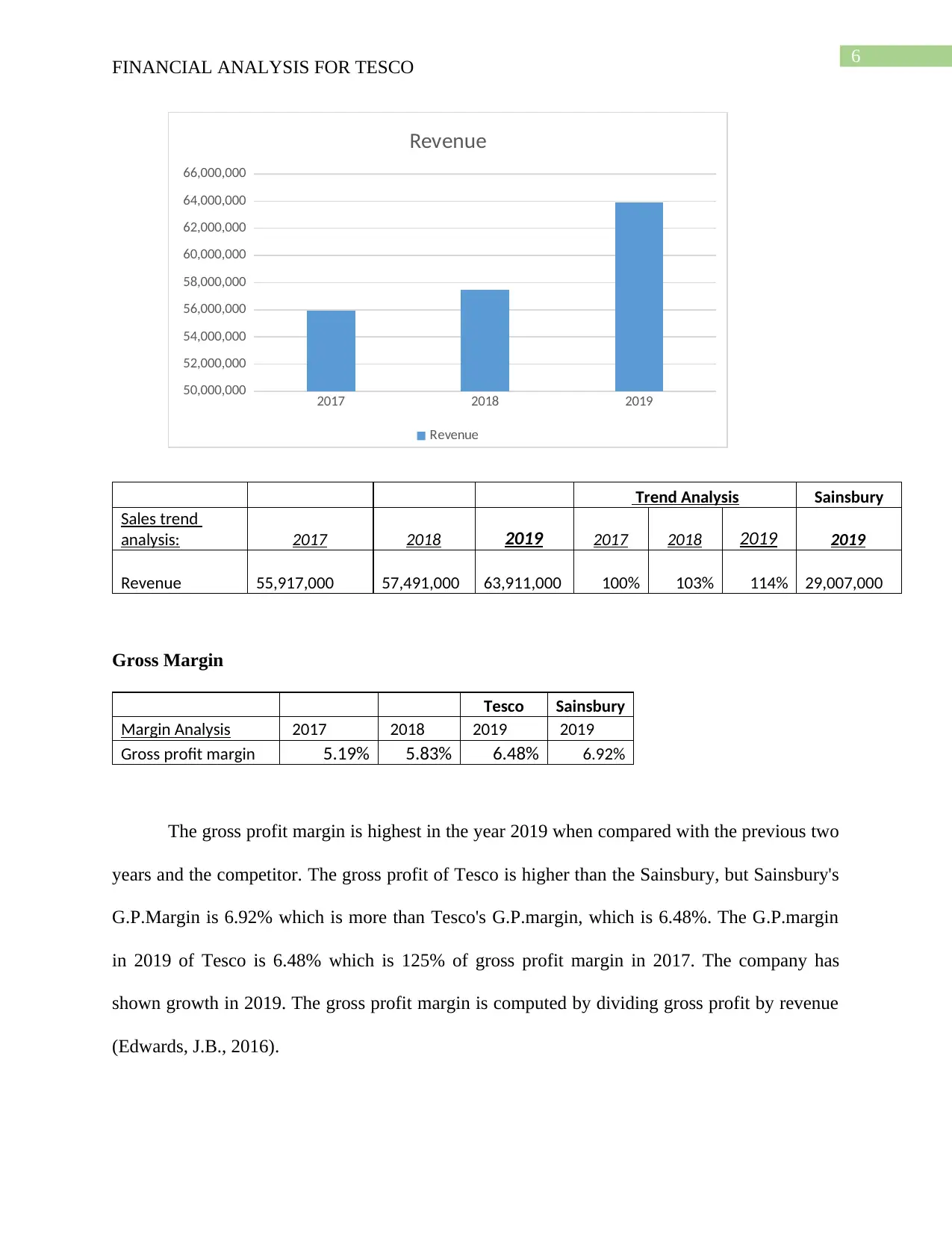
6
FINANCIAL ANALYSIS FOR TESCO
2017 2018 2019
50,000,000
52,000,000
54,000,000
56,000,000
58,000,000
60,000,000
62,000,000
64,000,000
66,000,000
Revenue
Revenue
Trend Analysis Sainsbury
Sales trend
analysis: 2017 2018 2019 2017 2018 2019 2019
Revenue 55,917,000 57,491,000 63,911,000 100% 103% 114% 29,007,000
Gross Margin
Tesco Sainsbury
Margin Analysis 2017 2018 2019 2019
Gross profit margin 5.19% 5.83% 6.48% 6.92%
The gross profit margin is highest in the year 2019 when compared with the previous two
years and the competitor. The gross profit of Tesco is higher than the Sainsbury, but Sainsbury's
G.P.Margin is 6.92% which is more than Tesco's G.P.margin, which is 6.48%. The G.P.margin
in 2019 of Tesco is 6.48% which is 125% of gross profit margin in 2017. The company has
shown growth in 2019. The gross profit margin is computed by dividing gross profit by revenue
(Edwards, J.B., 2016).
FINANCIAL ANALYSIS FOR TESCO
2017 2018 2019
50,000,000
52,000,000
54,000,000
56,000,000
58,000,000
60,000,000
62,000,000
64,000,000
66,000,000
Revenue
Revenue
Trend Analysis Sainsbury
Sales trend
analysis: 2017 2018 2019 2017 2018 2019 2019
Revenue 55,917,000 57,491,000 63,911,000 100% 103% 114% 29,007,000
Gross Margin
Tesco Sainsbury
Margin Analysis 2017 2018 2019 2019
Gross profit margin 5.19% 5.83% 6.48% 6.92%
The gross profit margin is highest in the year 2019 when compared with the previous two
years and the competitor. The gross profit of Tesco is higher than the Sainsbury, but Sainsbury's
G.P.Margin is 6.92% which is more than Tesco's G.P.margin, which is 6.48%. The G.P.margin
in 2019 of Tesco is 6.48% which is 125% of gross profit margin in 2017. The company has
shown growth in 2019. The gross profit margin is computed by dividing gross profit by revenue
(Edwards, J.B., 2016).
Paraphrase This Document
Need a fresh take? Get an instant paraphrase of this document with our AI Paraphraser
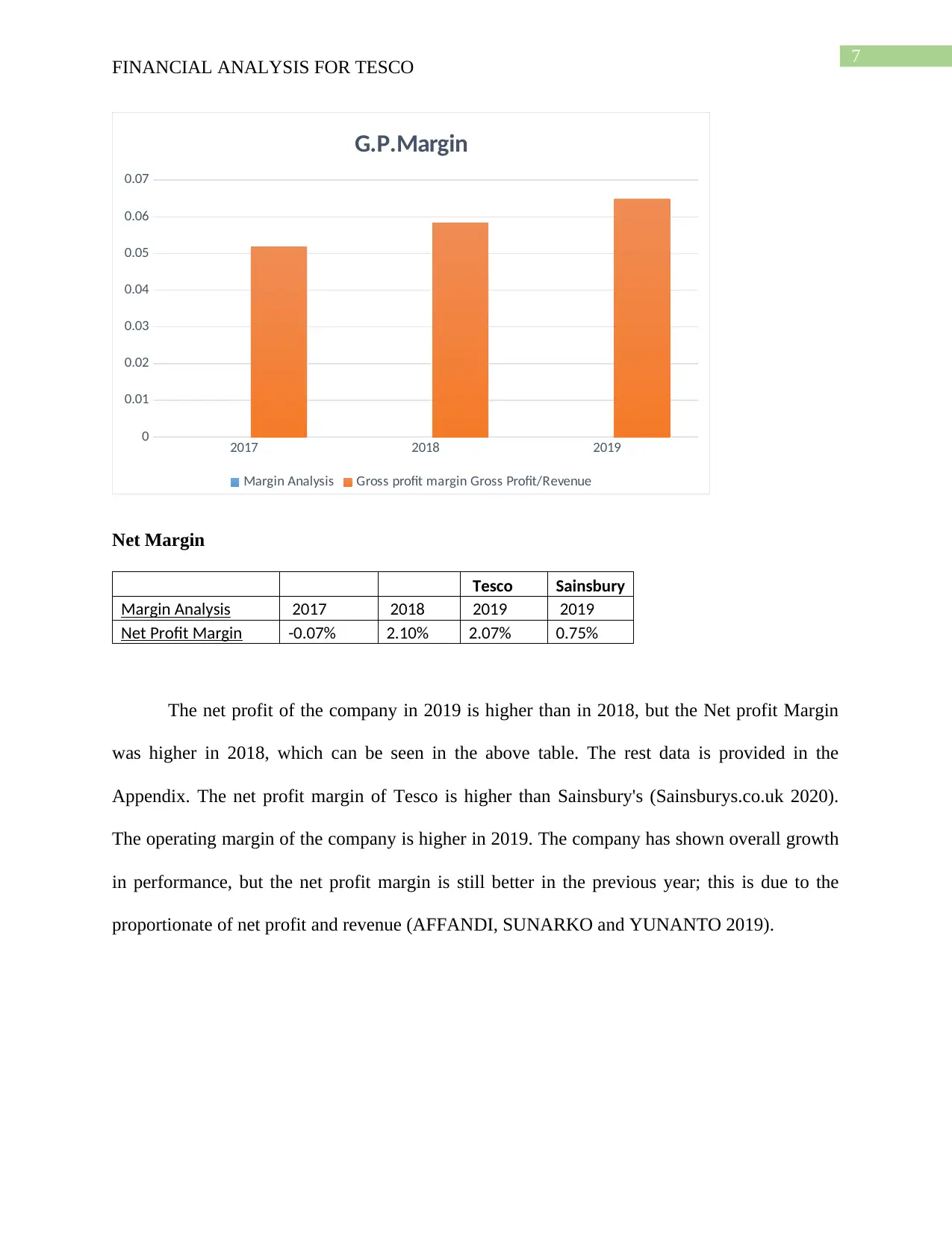
7
FINANCIAL ANALYSIS FOR TESCO
2017 2018 2019
0
0.01
0.02
0.03
0.04
0.05
0.06
0.07
G.P.Margin
Margin Analysis Gross profit margin Gross Profit/Revenue
Net Margin
Tesco Sainsbury
Margin Analysis 2017 2018 2019 2019
Net Profit Margin -0.07% 2.10% 2.07% 0.75%
The net profit of the company in 2019 is higher than in 2018, but the Net profit Margin
was higher in 2018, which can be seen in the above table. The rest data is provided in the
Appendix. The net profit margin of Tesco is higher than Sainsbury's (Sainsburys.co.uk 2020).
The operating margin of the company is higher in 2019. The company has shown overall growth
in performance, but the net profit margin is still better in the previous year; this is due to the
proportionate of net profit and revenue (AFFANDI, SUNARKO and YUNANTO 2019).
FINANCIAL ANALYSIS FOR TESCO
2017 2018 2019
0
0.01
0.02
0.03
0.04
0.05
0.06
0.07
G.P.Margin
Margin Analysis Gross profit margin Gross Profit/Revenue
Net Margin
Tesco Sainsbury
Margin Analysis 2017 2018 2019 2019
Net Profit Margin -0.07% 2.10% 2.07% 0.75%
The net profit of the company in 2019 is higher than in 2018, but the Net profit Margin
was higher in 2018, which can be seen in the above table. The rest data is provided in the
Appendix. The net profit margin of Tesco is higher than Sainsbury's (Sainsburys.co.uk 2020).
The operating margin of the company is higher in 2019. The company has shown overall growth
in performance, but the net profit margin is still better in the previous year; this is due to the
proportionate of net profit and revenue (AFFANDI, SUNARKO and YUNANTO 2019).
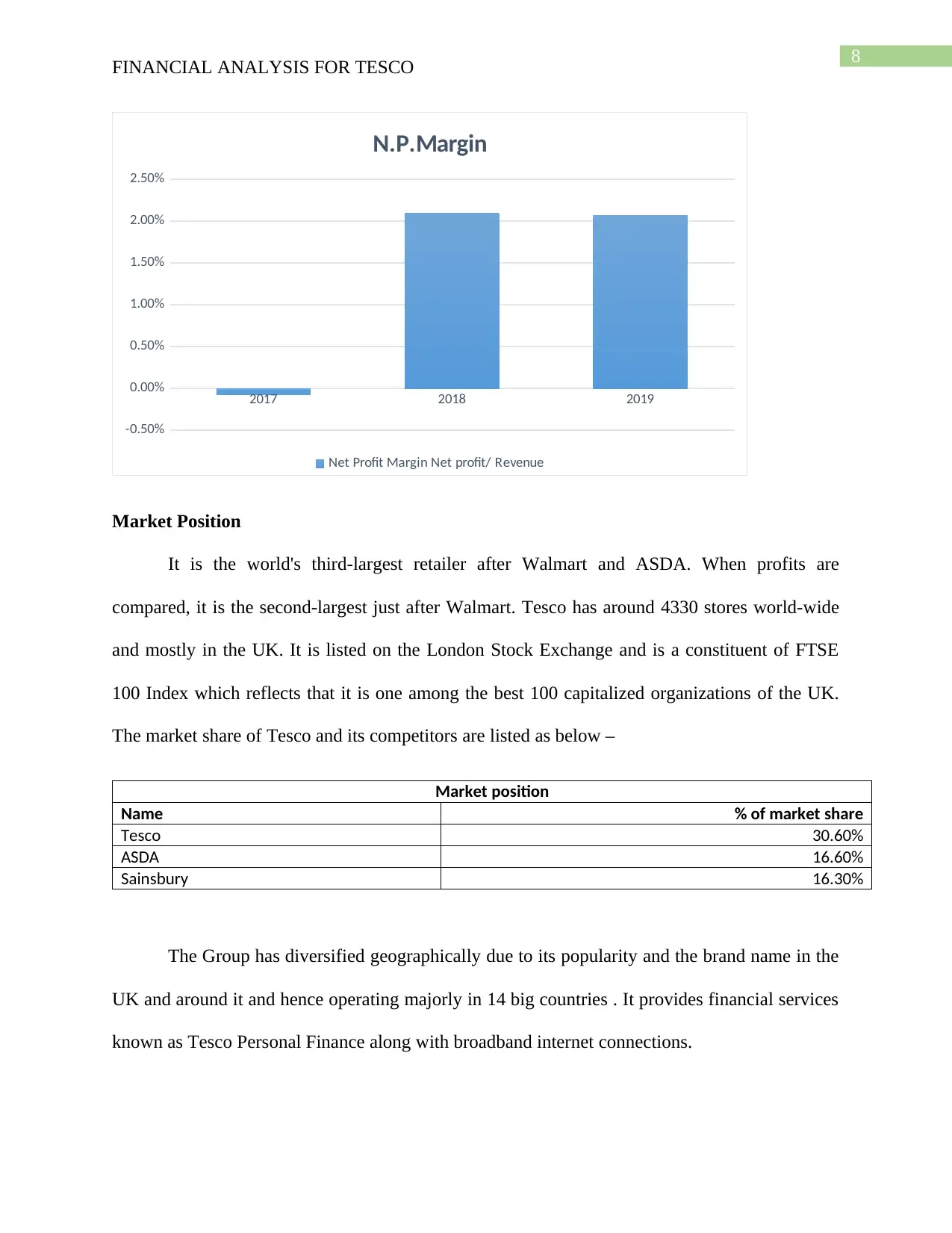
8
FINANCIAL ANALYSIS FOR TESCO
2017 2018 2019
-0.50%
0.00%
0.50%
1.00%
1.50%
2.00%
2.50%
N.P.Margin
Net Profit Margin Net profit/ Revenue
Market Position
It is the world's third-largest retailer after Walmart and ASDA. When profits are
compared, it is the second-largest just after Walmart. Tesco has around 4330 stores world-wide
and mostly in the UK. It is listed on the London Stock Exchange and is a constituent of FTSE
100 Index which reflects that it is one among the best 100 capitalized organizations of the UK.
The market share of Tesco and its competitors are listed as below –
Market position
Name % of market share
Tesco 30.60%
ASDA 16.60%
Sainsbury 16.30%
The Group has diversified geographically due to its popularity and the brand name in the
UK and around it and hence operating majorly in 14 big countries . It provides financial services
known as Tesco Personal Finance along with broadband internet connections.
FINANCIAL ANALYSIS FOR TESCO
2017 2018 2019
-0.50%
0.00%
0.50%
1.00%
1.50%
2.00%
2.50%
N.P.Margin
Net Profit Margin Net profit/ Revenue
Market Position
It is the world's third-largest retailer after Walmart and ASDA. When profits are
compared, it is the second-largest just after Walmart. Tesco has around 4330 stores world-wide
and mostly in the UK. It is listed on the London Stock Exchange and is a constituent of FTSE
100 Index which reflects that it is one among the best 100 capitalized organizations of the UK.
The market share of Tesco and its competitors are listed as below –
Market position
Name % of market share
Tesco 30.60%
ASDA 16.60%
Sainsbury 16.30%
The Group has diversified geographically due to its popularity and the brand name in the
UK and around it and hence operating majorly in 14 big countries . It provides financial services
known as Tesco Personal Finance along with broadband internet connections.
⊘ This is a preview!⊘
Do you want full access?
Subscribe today to unlock all pages.

Trusted by 1+ million students worldwide
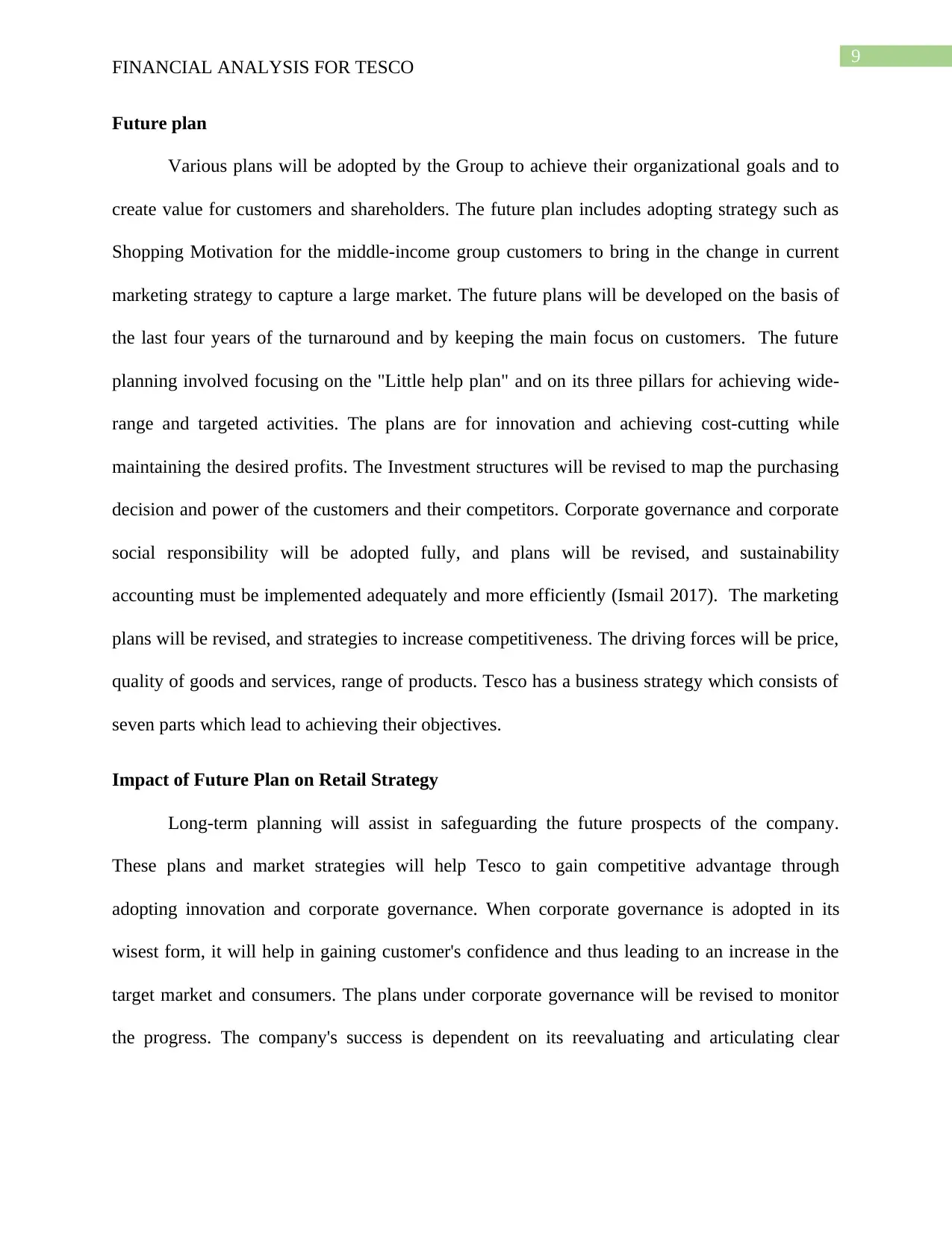
9
FINANCIAL ANALYSIS FOR TESCO
Future plan
Various plans will be adopted by the Group to achieve their organizational goals and to
create value for customers and shareholders. The future plan includes adopting strategy such as
Shopping Motivation for the middle-income group customers to bring in the change in current
marketing strategy to capture a large market. The future plans will be developed on the basis of
the last four years of the turnaround and by keeping the main focus on customers. The future
planning involved focusing on the "Little help plan" and on its three pillars for achieving wide-
range and targeted activities. The plans are for innovation and achieving cost-cutting while
maintaining the desired profits. The Investment structures will be revised to map the purchasing
decision and power of the customers and their competitors. Corporate governance and corporate
social responsibility will be adopted fully, and plans will be revised, and sustainability
accounting must be implemented adequately and more efficiently (Ismail 2017). The marketing
plans will be revised, and strategies to increase competitiveness. The driving forces will be price,
quality of goods and services, range of products. Tesco has a business strategy which consists of
seven parts which lead to achieving their objectives.
Impact of Future Plan on Retail Strategy
Long-term planning will assist in safeguarding the future prospects of the company.
These plans and market strategies will help Tesco to gain competitive advantage through
adopting innovation and corporate governance. When corporate governance is adopted in its
wisest form, it will help in gaining customer's confidence and thus leading to an increase in the
target market and consumers. The plans under corporate governance will be revised to monitor
the progress. The company's success is dependent on its reevaluating and articulating clear
FINANCIAL ANALYSIS FOR TESCO
Future plan
Various plans will be adopted by the Group to achieve their organizational goals and to
create value for customers and shareholders. The future plan includes adopting strategy such as
Shopping Motivation for the middle-income group customers to bring in the change in current
marketing strategy to capture a large market. The future plans will be developed on the basis of
the last four years of the turnaround and by keeping the main focus on customers. The future
planning involved focusing on the "Little help plan" and on its three pillars for achieving wide-
range and targeted activities. The plans are for innovation and achieving cost-cutting while
maintaining the desired profits. The Investment structures will be revised to map the purchasing
decision and power of the customers and their competitors. Corporate governance and corporate
social responsibility will be adopted fully, and plans will be revised, and sustainability
accounting must be implemented adequately and more efficiently (Ismail 2017). The marketing
plans will be revised, and strategies to increase competitiveness. The driving forces will be price,
quality of goods and services, range of products. Tesco has a business strategy which consists of
seven parts which lead to achieving their objectives.
Impact of Future Plan on Retail Strategy
Long-term planning will assist in safeguarding the future prospects of the company.
These plans and market strategies will help Tesco to gain competitive advantage through
adopting innovation and corporate governance. When corporate governance is adopted in its
wisest form, it will help in gaining customer's confidence and thus leading to an increase in the
target market and consumers. The plans under corporate governance will be revised to monitor
the progress. The company's success is dependent on its reevaluating and articulating clear
Paraphrase This Document
Need a fresh take? Get an instant paraphrase of this document with our AI Paraphraser

10
FINANCIAL ANALYSIS FOR TESCO
business strategies and future plans will enhance the retail strategy and will provide a value add
on.
Conclusion
Therefore it is to be concluded that Tesco is one of the world's largest retailer and has
shown overall growth in 2019. The company has a strong financial and market position in the
industry; however, the company needs to work on its liquidity position. The company has an
average solvency position, but again when the company wants to raise its debt or wants to
borrow funds for financing the activities, it might face issues since its debt ratio is at par. The
market position of the company is very good and has an excellent goodwill and brand name. The
future plans involve plans regarding corporate governance, business strategies, "Little Help
Plan," innovation. These plans will help in achieving business goals and mission of the Tesco
and help in gaining competitive advantage and increase in customer satisfaction.
FINANCIAL ANALYSIS FOR TESCO
business strategies and future plans will enhance the retail strategy and will provide a value add
on.
Conclusion
Therefore it is to be concluded that Tesco is one of the world's largest retailer and has
shown overall growth in 2019. The company has a strong financial and market position in the
industry; however, the company needs to work on its liquidity position. The company has an
average solvency position, but again when the company wants to raise its debt or wants to
borrow funds for financing the activities, it might face issues since its debt ratio is at par. The
market position of the company is very good and has an excellent goodwill and brand name. The
future plans involve plans regarding corporate governance, business strategies, "Little Help
Plan," innovation. These plans will help in achieving business goals and mission of the Tesco
and help in gaining competitive advantage and increase in customer satisfaction.
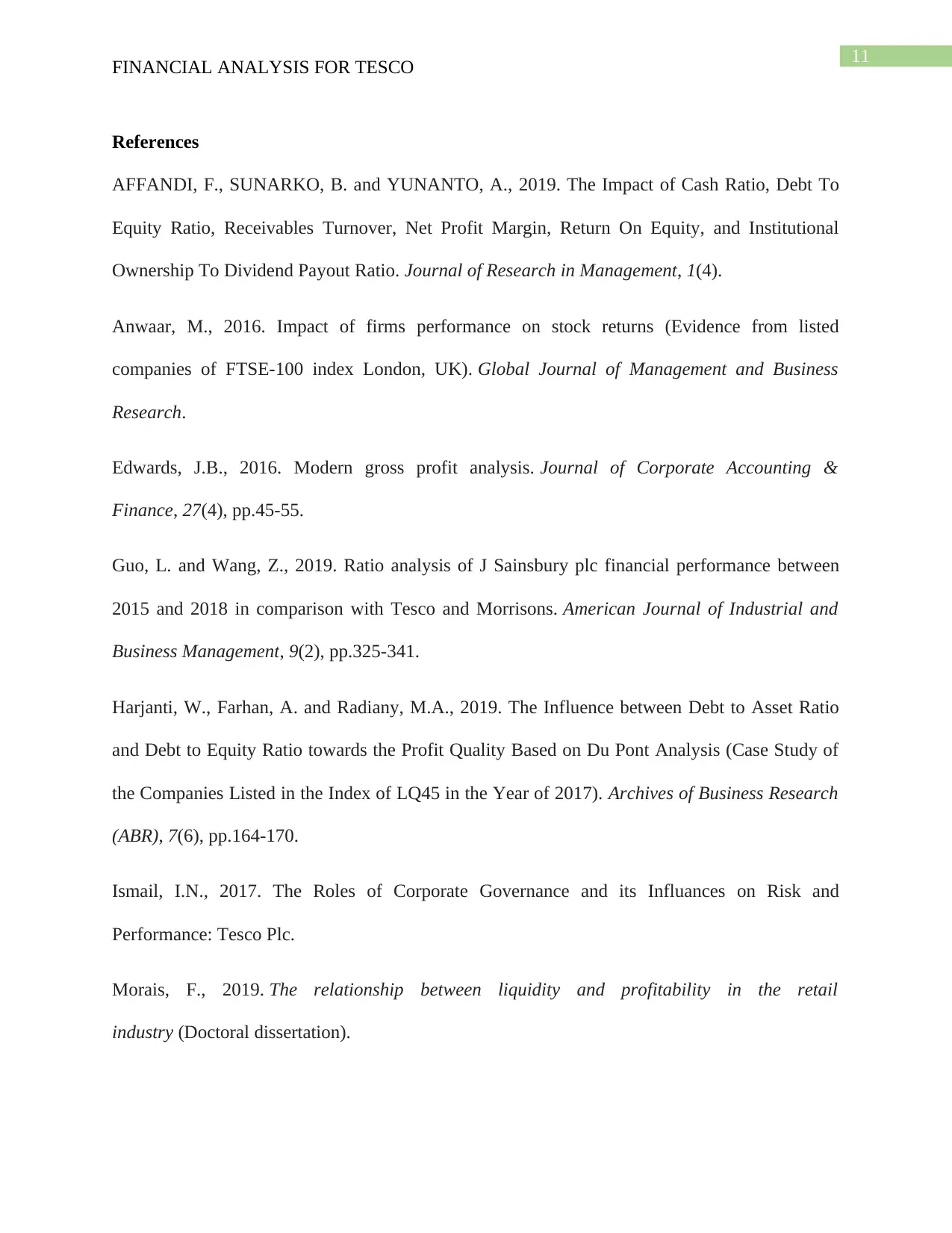
11
FINANCIAL ANALYSIS FOR TESCO
References
AFFANDI, F., SUNARKO, B. and YUNANTO, A., 2019. The Impact of Cash Ratio, Debt To
Equity Ratio, Receivables Turnover, Net Profit Margin, Return On Equity, and Institutional
Ownership To Dividend Payout Ratio. Journal of Research in Management, 1(4).
Anwaar, M., 2016. Impact of firms performance on stock returns (Evidence from listed
companies of FTSE-100 index London, UK). Global Journal of Management and Business
Research.
Edwards, J.B., 2016. Modern gross profit analysis. Journal of Corporate Accounting &
Finance, 27(4), pp.45-55.
Guo, L. and Wang, Z., 2019. Ratio analysis of J Sainsbury plc financial performance between
2015 and 2018 in comparison with Tesco and Morrisons. American Journal of Industrial and
Business Management, 9(2), pp.325-341.
Harjanti, W., Farhan, A. and Radiany, M.A., 2019. The Influence between Debt to Asset Ratio
and Debt to Equity Ratio towards the Profit Quality Based on Du Pont Analysis (Case Study of
the Companies Listed in the Index of LQ45 in the Year of 2017). Archives of Business Research
(ABR), 7(6), pp.164-170.
Ismail, I.N., 2017. The Roles of Corporate Governance and its Influances on Risk and
Performance: Tesco Plc.
Morais, F., 2019. The relationship between liquidity and profitability in the retail
industry (Doctoral dissertation).
FINANCIAL ANALYSIS FOR TESCO
References
AFFANDI, F., SUNARKO, B. and YUNANTO, A., 2019. The Impact of Cash Ratio, Debt To
Equity Ratio, Receivables Turnover, Net Profit Margin, Return On Equity, and Institutional
Ownership To Dividend Payout Ratio. Journal of Research in Management, 1(4).
Anwaar, M., 2016. Impact of firms performance on stock returns (Evidence from listed
companies of FTSE-100 index London, UK). Global Journal of Management and Business
Research.
Edwards, J.B., 2016. Modern gross profit analysis. Journal of Corporate Accounting &
Finance, 27(4), pp.45-55.
Guo, L. and Wang, Z., 2019. Ratio analysis of J Sainsbury plc financial performance between
2015 and 2018 in comparison with Tesco and Morrisons. American Journal of Industrial and
Business Management, 9(2), pp.325-341.
Harjanti, W., Farhan, A. and Radiany, M.A., 2019. The Influence between Debt to Asset Ratio
and Debt to Equity Ratio towards the Profit Quality Based on Du Pont Analysis (Case Study of
the Companies Listed in the Index of LQ45 in the Year of 2017). Archives of Business Research
(ABR), 7(6), pp.164-170.
Ismail, I.N., 2017. The Roles of Corporate Governance and its Influances on Risk and
Performance: Tesco Plc.
Morais, F., 2019. The relationship between liquidity and profitability in the retail
industry (Doctoral dissertation).
⊘ This is a preview!⊘
Do you want full access?
Subscribe today to unlock all pages.

Trusted by 1+ million students worldwide
1 out of 14
Related Documents
Your All-in-One AI-Powered Toolkit for Academic Success.
+13062052269
info@desklib.com
Available 24*7 on WhatsApp / Email
![[object Object]](/_next/static/media/star-bottom.7253800d.svg)
Unlock your academic potential
Copyright © 2020–2025 A2Z Services. All Rights Reserved. Developed and managed by ZUCOL.





